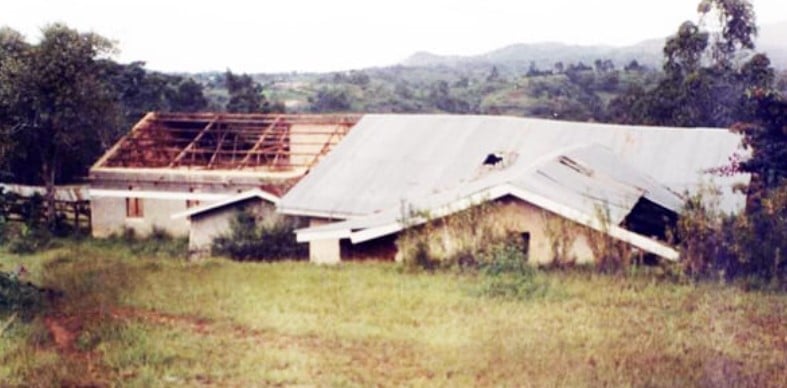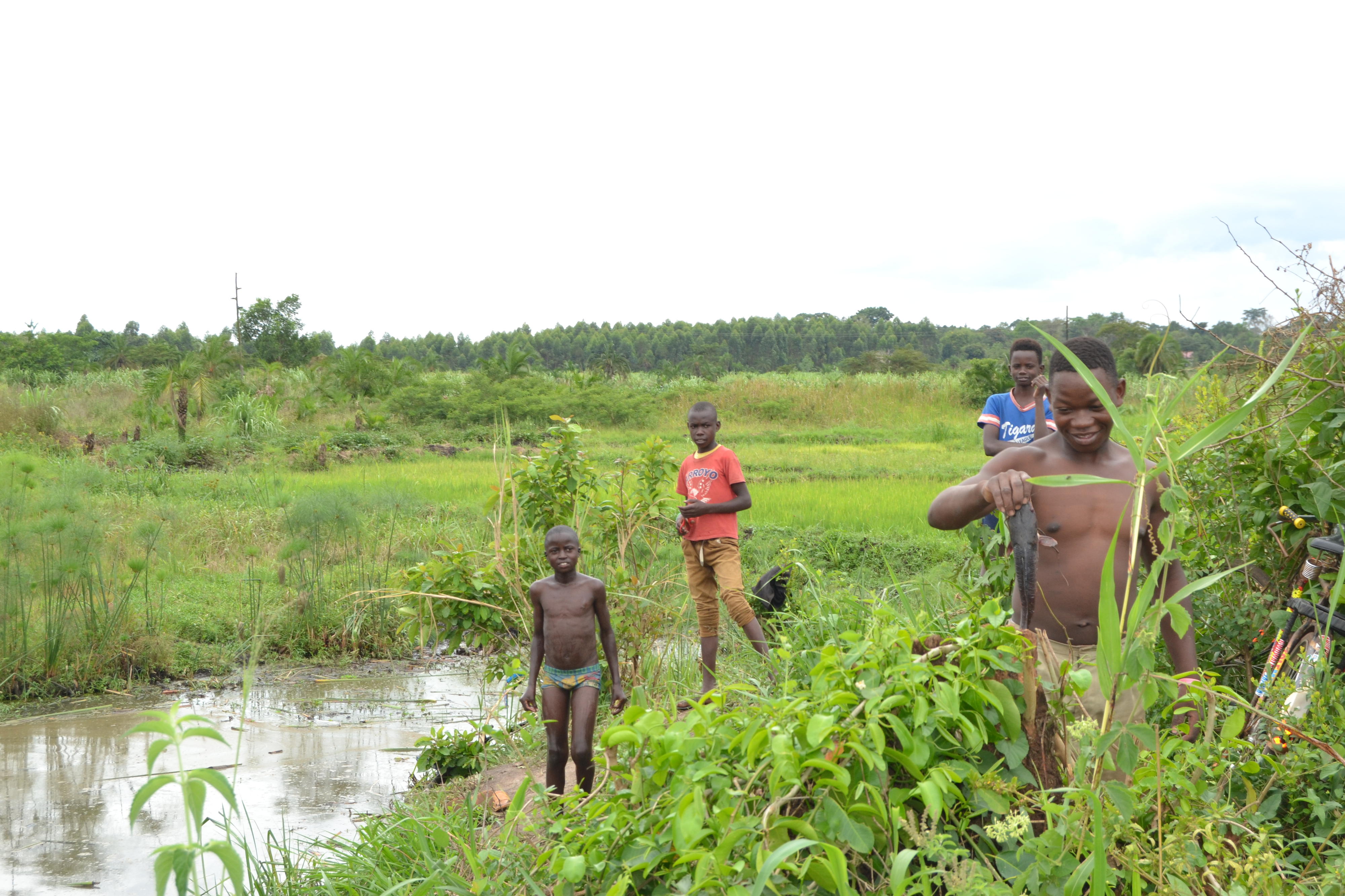Prime
How Mwerinde, Kataribabo ran doomsday cult with an iron fist

The former Kibwetere’s church premises at Nyabugoto in Kanungu District where hundreds were burnt to death. PHOTO/FILE
What you need to know:
- Joseph Kibwetere’s devotion to a doomsday cult, led by visions claimed by Credonia Mwerinde, resulted in his estrangement from his family and culminated in the deaths of over 1,000 followers in a tragic inferno.
Near the end of his life, Joseph Kibwetere one of the ring leaders of the Church of the Movement of the Restoration of the Ten Commandments, a doomsday cult that would later cause the death of more than 1,000 cult followers, wrote to his family from Kanungu, asking to return home to die. Circa 1997, Kibwetere was afflicted by mental ill health, diabetes and high blood pressure. His family, however, wrote back denying Kibwetere his dying wish.
“[In his letter to his family,] he also asked to come with his people, the Marians, to nurse him and the family told him, ‘if you are coming with your people you have no space here.’ And he told them that ‘if you deny me to come with my people, you are saying you are denying me from God. I can’t leave God for you! So if I come back home, I will come back with my people’,” said Jacob Katumusiime, whose doctoral thesis titled Beyond Religio-Cultural Violence: A Historic-Political Re-Contextualisation of the Movement for the Restoration of the Ten Commandments of God set out to peel back the mask of the cult.
In 1993, Kibwetere was once more forced to leave his home in Kabumba, Ntungamo where he lived with his wife Theresa and children, including Juvenall Rugambwa. Whereas in the past he had fled home due to political persecution and was exiled in Kabale, this time around he fell out with his family over his devotion to a new religious movement.
Another casualty of the political instability of post-independence Uganda, in which his once promising career as a politician, educator and civil servant had been curtailed, Kibwetere had, in utter desperation, joined a sect of the Marians who venerated the Virgin Mary. There he met Credonia Mwerinde, who like Kibwetere in 1984, claimed to have seen a vision of the Virgin Mary in March 1981.
Visions
Mwerinde’s visions of the Virgin Mary are believed to have manifested in the Nyabugoto caves that were a worship site in earlier generations for the Nyabingi cult per a 2017 study by Kizito Kiyimba titled, The Catholic Religion and Violence in Uganda’s History. The Nyabingi cult was led by an order of priestesses and was instrumental in mounting resistance to colonialism in Kigezi Sub-region circa 1910-1930.
By occupying the spaces of the extant cult, it is thought that Mwerinde’s visions attained a potency and legitimacy that served to position her as a medium for the Virgin Mary. Essentially, the day-to-day lives of the cult followers were ordered around Mwerinde’s visions, which directed followers to sell their property, take periodic vows of silence and refrain from speaking to outsiders.
“But the Catholic Church does not recognise the Marians; it says it needs to first prove that claims of visions of Mary are true,” Katumusiime told Saturday Monitor.
Rejected by the Catholic Church, the cult nonetheless continued growing and had two bases, including one in Kanungu led by Mwerinde, described by her nephew Santonino Kananura as “very enterprising by nature.” Kananura told us that while Mwerinde didn’t have much luck in love as well as a bar she started, “she returned to her father’s house where she established the church where the inferno happened.”
Boaz Idiidi, whose mother abandoned her family for the cult, says of Mwerinde: “She was responsible for teaching and popularising the cult’s message.” She for instance cited the example of the early church in the book of Acts “where she gave great meaning and significance to the story of Ananias and Sapphira, who died after failing to fulfil their pledge to sell their property and give the proceeds to the Church.” This was in a bid to get her Church members to sell their properties, which they did.
In 1990, after a visit to Kanungu, Kibwetere, moved by the squalor of his fellow adherents, invited Mwerinde’s camp to his home in Ntungamo where he hosted up to 300 at a time.
“Theresa started to suspect that Kibwetere and Credonia had a relationship. Kibwetere also started to beat his children for the first time,” Katumusiime disclosed, adding that such was the family feud that Kibwetere never attended the burial of his children lost in 1997.
That same year, Fr Dominic Kataribabo denied Theresa access to Kibwetere after he was bedridden. As this was happening, the cult was growing. In Nyabugoto-Kanungu, on land Mwerinde’s father, Paulo Petero Kashaku, donated, the cult was able to establish itself. This was not without incident.
“There was a young man, who was the son of one of Mwerinde’s brothers. His name was Kyomukama. He didn’t share the belief of the cult but exercised his right to use the family land and he built a house,” Kananura recalls. “However because the cult worked hand in glove with the local government leaders they got Kyomukama arrested and burnt down his house. He was eventually killed before the inferno, over the land.”
Ruthless Mwerinde
Upon the death of her father, Mwerinde sought ultimate control of the family land. This put the widow’s life in danger.
“They denied the old lady food and she nearly starved to death, however, an uncle of ours called Hans rescued her,” Kananura claims, adding that despite claims that Mwerinde kept the land title in possession of the local police, everything thing points to her and four children from the Kashaku household perishing in the inferno.
Given the mystique surrounding the cult and its leaders, Mwerinde’s role has been the subject of conjecture. She is considered the public face of the cult, its interlocutor with the local authorities.
“Credonia was in charge of the programme. When she said ‘this person should not last the night’ then that person would not,” Julius Rwamutwe, who lost his father, mother, three sisters and two brothers to the cult, told Saturday Monitor. “Credonia would also send emissaries to carry out her orders of moving people from camp to camp. That is why bodies were found at multiple sites.”
Mwerinde’s word became law for adherents of the cult and she incited fear in followers and cult leaders alike, as on her word one could be sanctioned and even demoted.
“Two letters were delivered to our home in Mitooma. We suspect that they were written by Credonia. Going by the contents of the letter which my father showed me, the author was convinced the world was coming to an end,” Rwamutwe recalls, adding, “The second letter was addressed to my school-going sister and said, ‘once you receive this letter leave school immediately and come to Kanungu, it is time. The end of the world is at hand.’”
Rwamutwe’s sister left for Kanungu never to return.
Fr Kataribabo led the second camp of this cult. He had studied theology at Loyola Marymount University in Los Angeles and ministered at St Anthony Catholic Church in El Segundo, California in the US. He was also the priest who presided over the wedding ceremony of Tarsis Kabwegyere, a former minister.
On his return to Uganda in 1987 after completing his Master’s degree in the US, Kataribabo suffered a series of disappointments that Katumusiime posits led him to the cult. “Fr Dominic Kataribabo is passed over for Bishop of Mbarara Catholic Diocese. The only reason is that he is a Munyaruguru. The Banyaruguru are not believed to be proper Banyankole. [...] They send Fr Kataribabo to Kampala to become chaplain of St Augustine Chapel, Makerere. And the Baganda say he is not a proper Muganda. He is frustrated.”
It is on the back of these frustrations that Fr Kataribabo started hosting the Marians. In 1991, the group received papal interdictions, essentially banning the group from communing. Fr Kataribabo was eventually excommunicated from the Catholic Church. The two camps of the cult, namely the Kanungu branch led by Mwerinde and the Kabumba camp led by Kibwetere used to meet to pray in Nyakisenyi. They ultimately settled in Kanungu on the land of Mwerinde’s father.
The velvet glove
After Kibwetere died in July 1999, Fr Kataribabo, who was the thinker and philosopher of the Movement, became the next and final Bishop of the Church of the Movement of the Restoration of the Ten Commandments.
Survivor testifies
Boaz Idiidi, a survivor, who lost his mother to the cult, recalls travelling from his father’s home in Nyamirama, Kanungu, as an 18-year-old. He headed to Nyabugoto to visit his mother, who was estranged from his father.
“He was a tall slender man with a dark complexion who led Mass with Fr Ikazire,” Idiidi says of Fr Kataribabo, adding, “He was cautious in his dealings and temperament and was a man of few words. When you were ill-disciplined, he called Credonia, who was the disciplinarian. I was unruly and I didn’t last long there.”
Fr Kataribabo, who was approachable in contrast to the aloof Kibwetere, conducted Mass in Rukiga, in the Roman Catholic tradition and included Holy Communion.
Idiidi petitioned Parliament on behalf of the survivors of the cult in 2014. The 10th Parliament instituted a probe led by the Defence and Internal Affairs Committee chaired by Betty Namugwanya, which presented a report to the House. Speaking on the floor of the 10th Parliament during a plenary debate of the committee report, Boaz Kafuda, the then Busongora South MP, revealed the more sinister face of the unassuming Fr Kataribabo.
“Madam Speaker in 2000, I was one of the people recruited by Rev Fr Dominic Kataribabo when I was in Senior Four at St Michael High School in Lugazi, Rubirizi District,” he started, adding; “When Rev Fr Dominic started killing people just near us because we were part of the people recruited, fortunately we were helped by our headmaster. By the time he conflicted with the Catholic Church, especially Lugazi Parish where he was a priest.”
Hundreds of bodies were exhumed from Kataribabo’s home in Bushenyi District per the committee report that in turn cited the police report informed by investigations carried out after the March 17, 2000 inferno.




